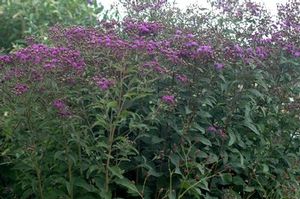New Moon Nurseries
Vernonia glauca
Upland ironweed
Native to North America
FIRST IMPRESSIONS: Vernonia glauca is an upright perennial wildflower with numerous lance shaped leaves. Foliage is toothed, dark green above and usually glaucous beneath. In late summer plants are crowned by compact corymbs of royal purple disc florets. Butterflies and other pollinators flock to the blooms. This species thrives in upland woods or in sunny gardens with average soil.
HABITAT & HARDINESS: Vernonia glauca occurs from Pennsylvania to Kentucky and south to Georgia, Alabama and Mississippi.
Plants are indigenous to open upland woods, dry or mesic meadows, fields and roadsides. Plants occur occasionally in alluvial habitats and are more frequent in the Piedmont and Mountains than in the Coastal Plain.
This species is hardy from USDA Zones 6-8.
PLANT DESCRIPTION: Vernonia glauca is an upright perennial wildflower with many stem leaves and no basal leaves.
Blades are oval to lance shaped and up to 8” long and 3” across. Leaves are toothed with pointed tips. Petioles may be short or absent. The lower leaf surface is usually whitish and glaucous.
From mid-summer until autumn, plants bear terminal flat topped flower corymbs. The inflorescences are composed of clusters of deep purple disc florets.
Each floret matures into a soft tan nutlet with a bristly straw colored pappus.
Plants are 3-5’ tall with an average 2-4’ spread.
CULTURAL & MAINTENANCE NEEDS: Vernonia glauca prefers full to part sun. Plants require good drainage and thrive in dry, moist or mesic soils and in acid, neutral or alkaline pH.
This species is pest resistant but foliage is occasionally nibbled by deer and other herbivores.
LANDSCAPE USES: In bloom, Vernonia glauca is a dramatic Accent for a Wildlife Garden or Meadow. Plants are lovely in combination with native grasses and golden fall flowers. Plants are also used as Butterfly Nectar Plants, Cut Flowers or as part of a Grouping or Mass Planting. This wildflower has Showy Blooms and can be used in Cottage Gardens, Water-wise Landscapes, Low Maintenance Plantings or Perennial Borders.
COMPANION & UNDERSTUDY PLANTS: Try pairing Vernonia glauca with Aster laevis, Echinacea purpurea, Monarda fistulosa, Liatris spicata, Rudbeckia fulgida var. fulgida, Solidago rugosa ‘Fireworks’, Sorghastrum nutans, Schizachyrium scoparium or Andropogon virginicus.
Vernonia noveborecensis is slightly taller and less drought tolerant but would be a worthy substitute in some situations.
TRIVIA: Unlike most other members of the Aster Family, Vernonia spp. flowers are composed only of disc florets with no rays.
Flowers attract bevies of butterflies, skippers, moths and native bees.
Vernonia glauca is similar in appearance to Vernonia noveborecensis. V. glauca is shorter, more tolerant of dry sites and generally has leaves with glaucous or whitish undersides. The two species also differ in the color of the pappus. A pappus is the modified calyx that occurs at the base of the floret and persists as an attachment to the seed. The pappus of Vernonia spp. looks like a cluster of bristly hairs. V. glauca has a straw colored or almost white pappus while V. noveborecensis has a darker brownish or purple pappus.
The generic name honors English botanist William Vernon (1666-1711) who collected and identified plants in Maryland. The specific epithet refers to the glaucous underside of the leaves.
Height:
3-5 ftSpread:
2-4 ftSpacing:
3 ftUSDA Hardiness Zone:
6-8Bloom Color:
PurpleVernonia glauca Characteristics
Attracts Wildlife
- Butterflies
- Pollinators
Attributes
- Naturalizing
- Long Blooming
- Drought Tolerant
- Dried Flower
- Cut Flower
- Rock Garden
Exposure
- Full Sun to Partial Shade
Flowering Months
- September
- August
Foliage Color
- Green
Growth Rate
- Medium
Juglans nigra Tolerance (Black Walnut)
- Yes
Season of Interest (Foliage)
- Summer
- Spring
Soil Moisture Preference
- Moist to Dry
Interesting Notes:
For more information on this plant, visit the USDA PLANTS Database: http://plants.usda.gov/java/profile?symbol=VEGL
